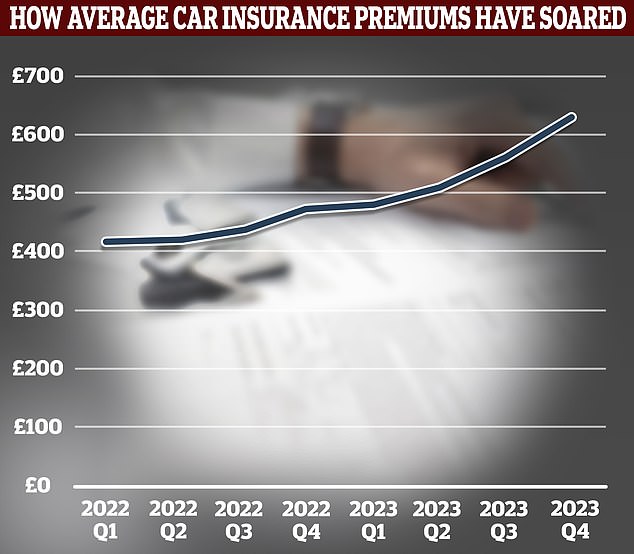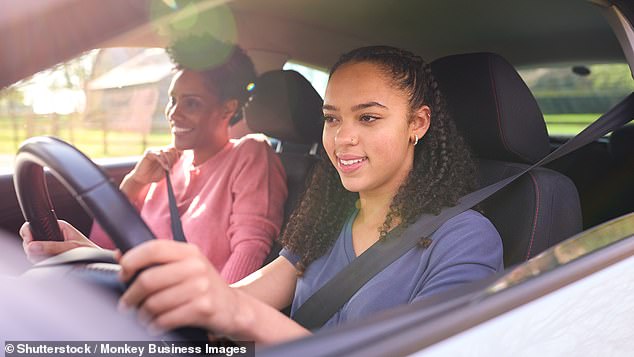Young motorists now face £8,000 in costs just to get on the road in their first year
New data shows that young people under the age of 21 who want to hit the road face much higher costs than their parents.
What should be a time of excitement and independence has turned into a financial speed bump that is too big for many.
According to the latest edition of MoneySupermarket’s Household Money Index, it costs an average of £7,609 for a 17 to 20 year old to drive and drive a car in their first year.
In 1989, the average young motorist had to pay £1,285 (£3,234 adjusted for inflation) to get on the road. It represents an increase of 135 percent in 35 years.
It will cost young people a massive 135 percent above the inflation rate of the past 35 years by 2024, compared to 1989 when it cost £3,234 (adjusted for inflation)
These figures vary 13 percent across Britain: London is the most expensive, costing an average of £8,422, while in Cardiff it costs £7,309.
Nearly half of young people said they could not afford to drive without financial help from their parents.
And the majority of under-25s (53 percent) who had put off learning to drive said they had avoided it because it was too expensive.
Many children hope their parents can pitch in and help, but to top it all off for keen drivers, parents who took part in the survey estimated they could only contribute £990 – or 13 per cent of the amount needed.
While most people would have taken a Saturday job to cover the cost of lessons or done odd jobs around the house and community for pocket money, that just isn’t enough these days.
The HMI found that a 17-year-old would need to work more than 1,188 hours to cover the costs of their first year on the road.
With 17-year-olds earning a minimum wage of just £6.40 an hour, teenagers would have to spend more than half their annual income on driving.

The biggest reason for the cost increase came from the huge increase in insurance premiums – something This is Money has discussed in detail
To calculate the cost of getting on the road, MoneySupermarket’s HMI – one of the most in-depth cost analyzes of getting on the road – took into account the purchase of a driver’s license, lessons and an exam, plus the cost of actually driving – buying a car, insurance, fuel and costs such as ULEZ and parking tickets.
The biggest reason for the increase in costs is the increase in insurance premiums.
According to data from the comparison website, insurance has risen more than five times as fast as inflation since 2019: 27 percent.
In 2023, the average car insurance premium rose by 25 percent, with the Association of British Insurers (ABI) reporting the average premium was £543, up from £434 in 2022.
In 2019, the average insurance quote for a 17 to 20 year old was £1,240 – today it is £1,700.

Although driving with your children may seem like a cost-effective alternative, once you have taken the tax into account in time, the HMI shows that it makes more sense if you can afford to contribute to learning to drive and purchasing a car for your child.
Is driving with your children a solution?
MoneySupermarket found that the average parent in the 17 to 20 age group spends 9.3 hours per month or 4.6 days per year transporting their children – costing them £1,336 per year.
Spread over the three years between ages 17 and 20, the value of the lifts parents give their children would pay for 31 percent of their total car costs over the same period.
But the HMI thinks it’s a better investment (if you can afford it) to spend this money on paying your kids to drive, rather than on a taxi service.
Paying for your children’s driver’s license, lessons and first year of insurance averages £3,658, leaving them to manage the cost of the car, plus fuel, taxes and charges. And parents get that well-deserved time back.
Sara Newell from MoneySupermarket said: ‘Parents of today’s young drivers generally had a much cheaper experience when it was our turn to hit the road.
’95 percent of people we asked underestimated how much it costs for young drivers today – which is no surprise, considering it’s 135 percent above the rate of inflation over the past 35 years.
‘If you’re faced with the decision to start working as a taxi operator, or to help out financially so your children can get on the road, it’s not an easy choice – as our latest Household Money Index shows.’
Some links in this article may be affiliate links. If you click on it, we may earn a small commission. That helps us fund This Is Money and keep it free to use. We do not write articles to promote products. We do not allow a commercial relationship to compromise our editorial independence.
